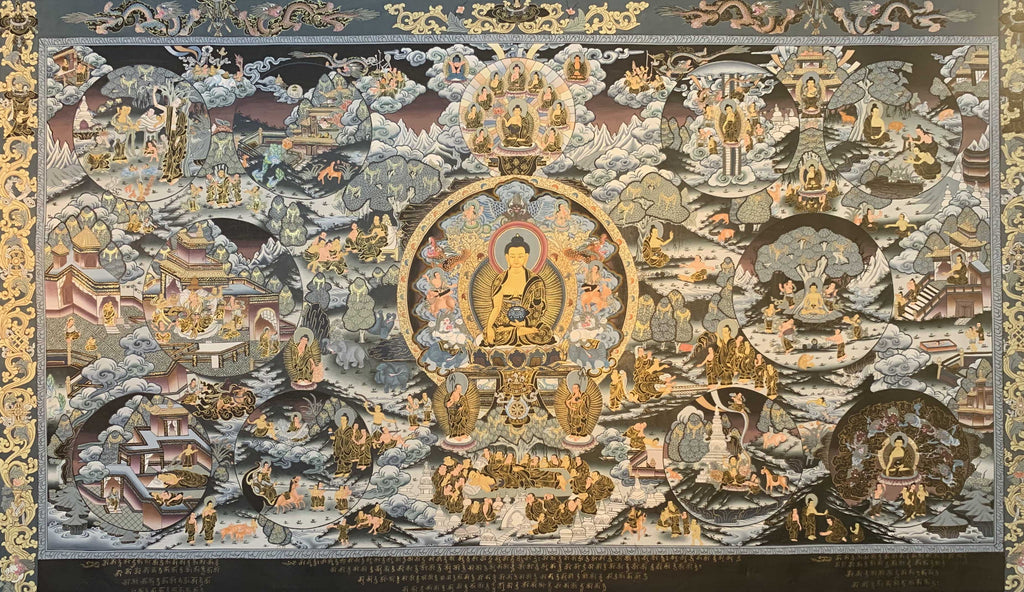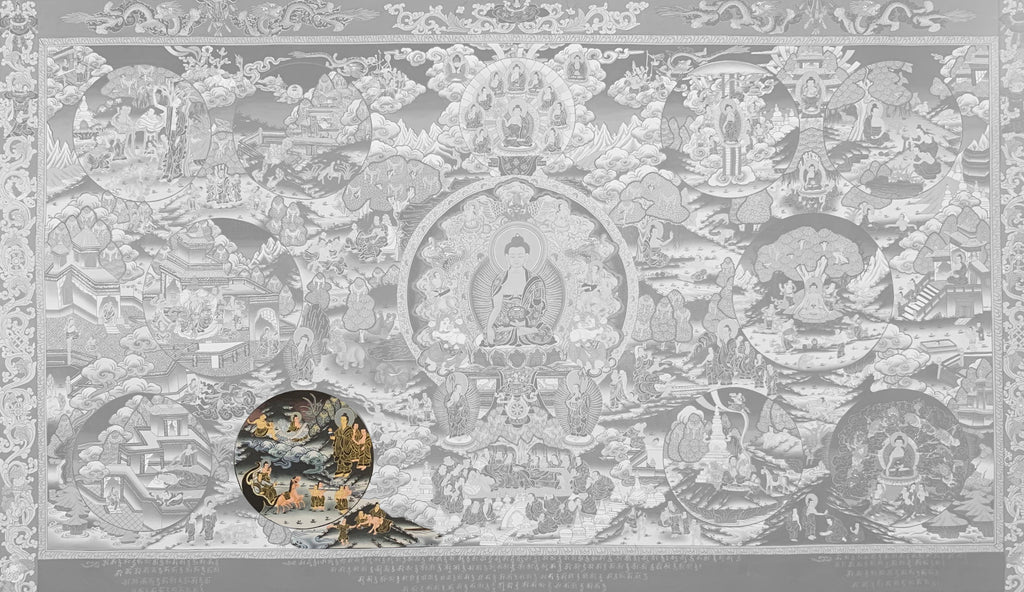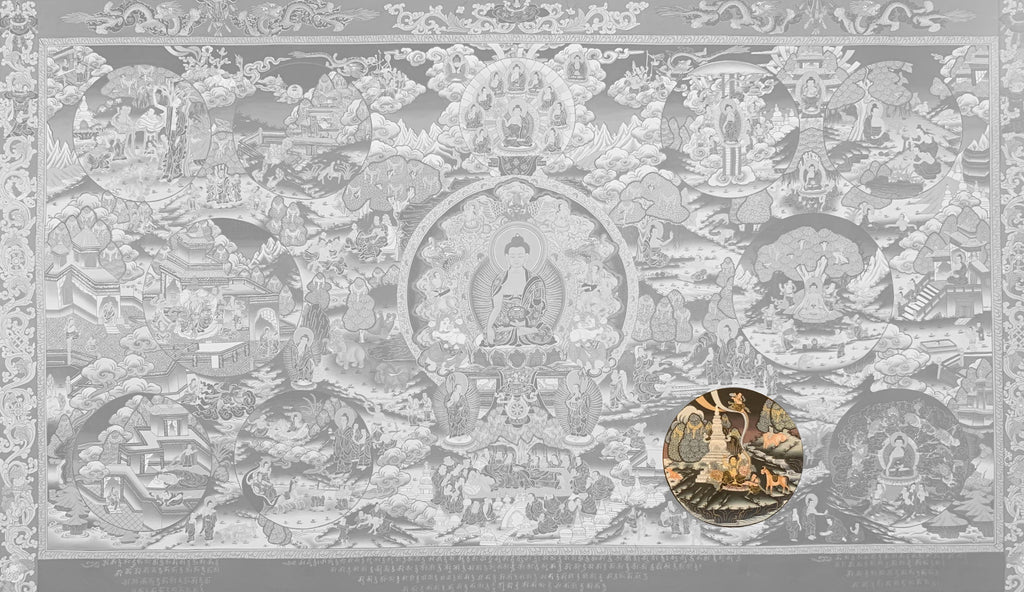
The Life Of Buddha In Traditional Thangka Paintings
Share
The thangka paintings of the life of the Buddha depicts key episodes in the life of Siddhartha Gautama, known as Gautama Buddha. These major events are traditionally called within the Mahayana sources the "Twelve Great Deeds of the Buddha's Life" (མཛད་པ་བཅུ་གཉིས་, dzepa chunyi in Tibetan).
The Twelve Great Deeds of the Buddha's Life are:
- Descent from Tushita heaven.
- Entering the womb of his mother, Mayadevi.
- Taking birth.
- Becoming skilled in various arts.
- Delighting in the company of royal consorts.
- Developing renunciation and leaving the royal palace.
- Practicing austerities for six years.
- Striving for enlightenment to the foot of the bodhi tree.
- Overcoming Mara’s demons.
- Becoming fully enlightened.
- Turning the wheel of Dharma.
- Passing into mahaparinirvana.
The paintings of the Buddha's life at times portray more of the meaningful events and encounters in his life other than these twelve deeds. At the early Theravada tradition the deeds are divided differently:
- The descent from Tushita.
- Entering the mother’s womb.
- Taking birth.
- Leaving his family.
- Overcoming Mara,
- Turning the wheel of Dharma.
- Passing into nirvana or parinirvana.
These thangka paintings are not meant to be solely illustrations of the events in the life of the historical Buddha, but they are also seen to be a visual representation of different philosophical aspects of Buddhism, especially the gradual progress towards the achievement of spiritual enlightenment.
View interactive thangka explanation

The visual presentation of the Twelve Great Deeds of the Buddha's Life and other major events
The Buddha's promise to take birth in the human realm and to descent from Tushita heaven


The Bodhisattva Mahasattva gave his last teaching to the countless bodhisattvas in Tushita Pure Land. He made a promise to be reborn again in the human realms to guide human beings to liberation from the ocean of cyclic existence.
Entering the womb of his mother, Mayadevi

In the city of Kapilavastu, on the night Siddhartha was conceived, his mother Queen Maya dreamt that a white elephant with six white tusks entered her right side. It was the night of the full moon on the fifteenth day of the month of Vesak (fourth month of the lunar calendar).

Taking birth


When Queen Maya knew the time of the birth was near, she left Kapilvastu for her father's kingdom to give birth. However, her son was born on the way, at Lumbini, in a garden while she was holding a branch of a sal tree.
According to legend, Buddha was born from the right side of his mother. Immediately upon his birth, he stood up and took seven steps in each of the four directions, raised his hand and said: "Thus have I come for the wellbeing of the world."
At the time of birth the Hindu gods Indra and Brahma were present. In the painting Indra stands ready, holding a cloth to wrap the baby.
Mastery of learning and athletics


Delighting in the company of royal consorts

After growing up, prince Siddhartha assumed royal duties. He married the beautiful princess Yashodhara at the age of 21 and they had a son together named Rahaula. and had a retinue of many attendant ladies. The painting depicts him in his royal robes at the court while enjoying the company of the royal consorts.

The four encounters

Prince Siddhartha ventured beyond the gates for the first time with his faithful charioteer Channa and they had a series of encounters known as "the four sights". First they encountered an old man, then a sick man, and then a corpse. From these sights the prince began to understand the nature of suffering in the world. The fourth encounter was with an ascetic holy man, who seemed content and at peace with the world.

Leaving his family and the royal palace

After his father the king refused his request to set on a spiritual quest, the prince left the palace in the middle of the night, together with Channa the charioteer, leaving behind his sleeping wife and son.

Renunciation of worldly life

The first thing Prince Gautam did after leaving his father's palace was to severe his long and beautiful hair with his princely blade as a way of showing he is renouncing his previous worldly life.

Practicing austerities for six years


Siddhartha Gautama studied with several teachers, and in each case, he mastered the meditative attainments each of them taught. Yet he found that what he learn from these teachers did not provide a permanent end to suffering, so he continued his spiritual quest.
He next joined a group of five other ascetics and for the next several years, Siddhartha practiced extreme austerities along with his companions. These austerities included prolonged fasting, breath-holding, and exposure to pain. Siddhartha almost starved himself to death in the process, becoming so skinny that when he touched his stomach, he could almost feel his spine.
He then realized that it was not possible to attain enlightenment through asceticism alone.
Striving for enlightenment to the foot of the bodhi tree


After realising that asceticism is the the right path he met a young village girl named Sujata who offered him a bowl of rice pudding (kheer). It was the first food he had accepted in years and it instantly restored his strength. He went to Bodhgaya in Magadha to attain enlightenment. He sat under the Bodhi Tree and vowed not to rise before attaining enlightenment.
Overcoming Mara’s demons


While siddhartha was sitting at the Bodhi Tree, Mara, the demon of death and desire, sent many kinds of hosts, both wrathful and sensual, to defeat and lure him. Yet he remained concentrated an unmoved by all of these demons sent to him.
After defeating Mara's demons, he touched the earth with his right hand and summoned the Earth Goddess to be his witness.
Becoming fully enlightened

The Buddha sat under the tree in solitude. He saw his countless past lives and the beings who have perished in the cycle of endless rebirths. During the third watch of the night he attained full enlightenment.
Turning the wheel of Dharma


After his enlightenment, the buddha kept sitting and contemplating for seven more weeks under the Bodhi Tree. The gods Brahma and Indra beseeched him not to pass into Nirvana but to teach other beings in the world.
He went to Varanasi to "turn the wheel of the Dharma" for the first time at the Deer Park. He ordained the five ascetics as his first disciples, and taught the Four Noble Truths.
Descent from the Trayastrimsa Heaven

Passing into mahaparinirvana


